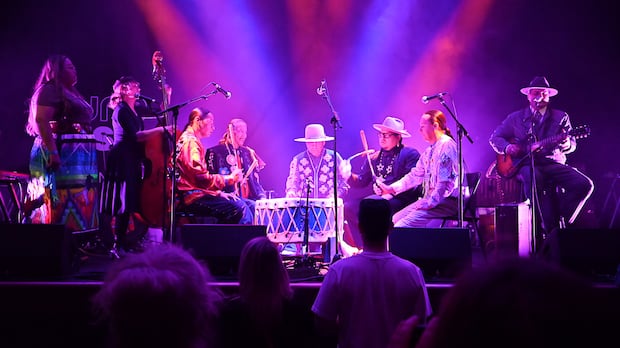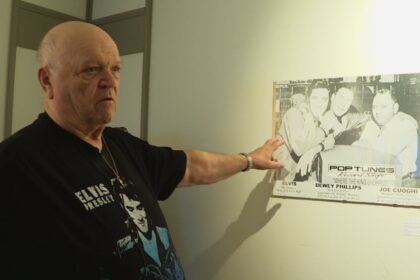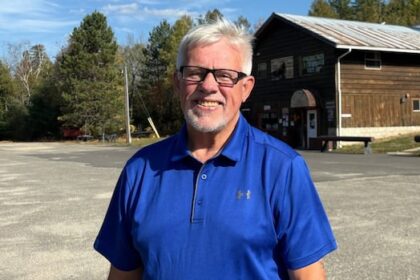IndigenousBlue Moon Marquee and Northern Cree have collaborated on a new album. They say the musical genres work together because they have commonalities. Blue Moon Marquee collaboration with Northern Cree releases FridayCandace Maracle · CBC News · Posted: Oct 24, 2025 4:00 AM EDT | Last Updated: 9 hours agoListen to this articleEstimated 4 minutesNorthern Cree centre stage, flanked by Blue Moon Marquee on stage in Vancouver during JunoFest in March 2025. (Submitted by Blue Moon Marquee)A collaboration between a blues duo and a powwow drum group came together with ease thanks to commonalities between the two genres, says one of the artists behind it. Get Your Feathers Ready drops Friday and A.W. Cardinal, vocalist and guitarist for Blue Moon Marquee, said it’s one of the most powerful albums of his career. “Indigenous music and blues music kind of have always walked hand in hand,” Cardinal said.Blue Moon Marquee is a swing-blues duo from British Columbia. They collaborated with Northern Cree, a powwow and round dance drum and singing group based in Maskwacis, Alta. Cardinal, who is from Beaver Lake Cree Nation in northern Alberta, said he’s known for a long time how similar the blues and powwow music are. He said once the two groups got in the studio they realized “it was really easy to make it click and powerful.””Blues is all about call and response and if you listen to any powwow song, they have call and response,” said Cardinal.This is Blue Moon Marquee and Northern Cree’s first collaboration. (Submitted by Blue Moon Marquee)Cardinal said he let Northern Cree take the lead in the studio, saying their singing was like “watching a flock of birds.” “All of a sudden the whole flock turns left and they all do it at the same time,” he said.Northern Cree are asked to collaborate often; their music has been sampled in popular music by the likes of M.I.A., Santigold and The Halluci Nation.Steve Wood, the group’s founder and drum keeper from Saddle Lake Cree Nation, said more and more people are connecting to the “heartbeat” of the traditional drum.“When we go out to perform, there’s a lot of people who are non-Native that are in the audience and I’m finding it probably reaches out to them and touches them the same way as it touches us,” he said.“It’s probably the oldest form of music on this land, but it’s new to a lot of people.”He said he writes Cree lyrics to accompany music and said his son, Joel Wood, has an ear for timing the drum beat with the music it’s accompanying, so it sounds good with the other instruments and vocals. Indigenous contribution to the bluesElaine Bomberry, a blues historian from Six Nations of the Grand River near Hamilton, Ont., produced Rez Bluez, a Toronto concert series featuring Indigenous blues musicians.Bomberry said she was impressed when she first heard a teaser from the album and called it “the affirmation we needed for this genre of Indigenous blues.”She said blues originates from the drum, an instrument that’s the “steady heartbeat” connecting the two genres.Blues music runs deep in her community, she said. Because of its location, she could choose between AM radio stations from Buffalo, Detroit and Chicago as well as Toronto, playing blues. Bomberry said there’ve only been a few musicians who have included the traditional drum with the blues, including her husband Murray Porter, but it’s been a while since she’s heard it.Get Your Feathers Ready album cover art. (Submitted by Blue Moon Marquee)Bomberry said Indigenous music and the blues were a complement to one another dating back to when First Nations helped runaway slaves.Delta blues musician Charley Patton is believed to have Native American ancestry as well as other legends like Howlin’ Wolf’ and Link Wray, Cardinal said.“[Patton] taught a lot of people how to play guitar and sing and he sang about being back on the nation, being on the territory,” Cardinal said. Jasmine Colette, vocalist, bassist and drummer for Blue Moon Marquee said she’s heard people say the new album feels new and ancient at the same time.“Our hope is that it won’t just be played on Indigenous radio but also on mainstream radio as it should,” Colette said.“And people will hear that this sound has always been there and the profound influence that Native Americans have had on popular American music since the very beginning…. That influence has been in the shadows for way too long.”ABOUT THE AUTHORCandace Maracle is Kanien’kehá:ka, Wolf Clan from Tyendinaga Mohawk Territory. She has a master’s degree in journalism from Toronto Metropolitan University. Her latest short film, “Tsi ní:yoht yonkwayentá:’on ne óhses” (How We Got Maple Syrup) is completely in the Kanien’kéha language.
Wednesday, 17 Dec 2025
Canada – The Illusion
Search
Have an existing account?
Sign In
© 2022 Foxiz News Network. Ruby Design Company. All Rights Reserved.
You May also Like
- More News:
- history
- Standing Bear Network
- John Gonzalez
- ᐊᔭᐦᑊ ayahp — It happened
- Creation
- Beneath the Water
- Olympic gold medal
- Jim Thorpe
- type O blood
- the bringer of life
- Raven
- Wás’agi
- NoiseCat
- 'Sugarcane'
- The rivers still sing
- ᑲᓂᐸᐏᐟ ᒪᐢᑿ
- ᐅᑳᐤ okâw — We remember
- ᐊᓂᓈᐯᐃᐧᐣ aninâpêwin — Truth
- This is what it means to be human.
- Nokoma











